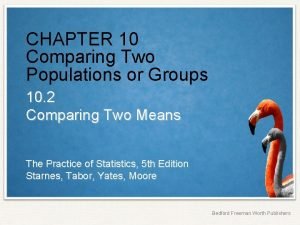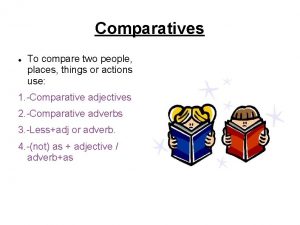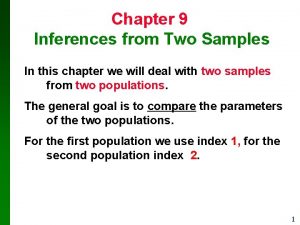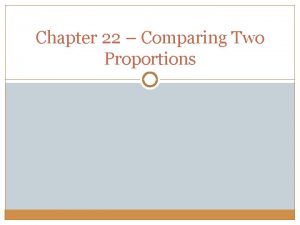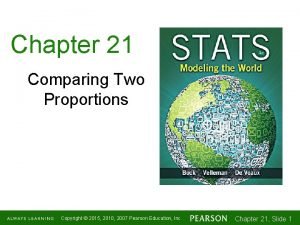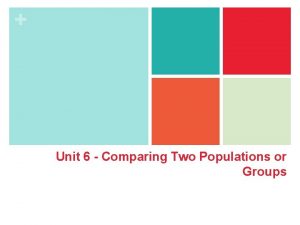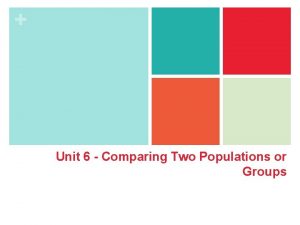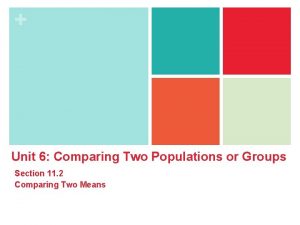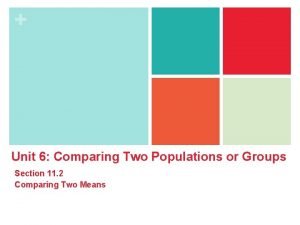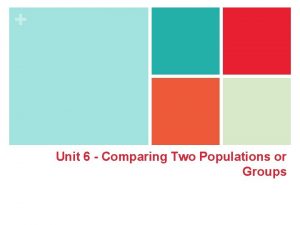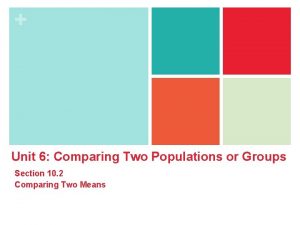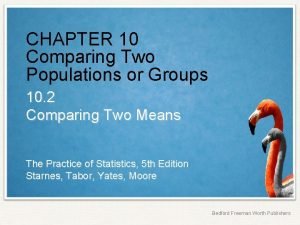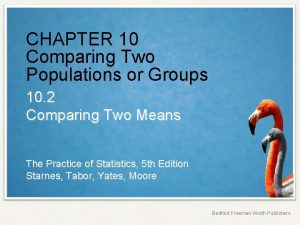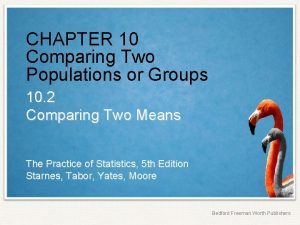Unit 6 Comparing Two Populations or Groups Unit












- Slides: 12

+ Unit 6 - Comparing Two Populations or Groups

+ Unit 6 - Comparing Two Populations or Groups n 12. 2 Comparing Two Proportions n 11. 2 Comparing Two Means

+ Section 12. 2 Comparing Two Proportions Learning Objectives After this section, you should be able to… ü PERFORM a significance test to compare two proportions. ü INTERPRET the results of inference procedures in a randomized experiment.

Tests for p 1 – p 2 We’ll restrict ourselves to situations in which the hypothesized difference is 0. Then the null hypothesis says that there is no difference between the two parameters: H 0: p 1 - p 2 = 0 or, alternatively, H 0: p 1 = p 2 The alternative hypothesis says what kind of difference we expect. Ha: p 1 - p 2 > 0, Ha: p 1 - p 2 < 0, or Ha: p 1 - p 2 ≠ 0 If the Random, Normal, and Independent conditions are met, we can proceed with calculations. Comparing Two Proportions An observed difference between two sample proportions can reflect an actual difference in the parameters, or it may just be due to chance variation in random sampling or random assignment. Significance tests help us decide which explanation makes more sense. The null hypothesis has the general form H 0: p 1 - p 2 = hypothesized value + n Significance

Tests for p 1 – p 2 Comparing Two Proportions If H 0: p 1 = p 2 is true, the two parameters are the same. We call their common value p. But now we need a way to estimate p, so it makes sense to combine the data from the two samples. This pooled (or combined) sample proportion is: + n Significance

If the following conditions are met, we can proceed with a twosample z test for the difference between two proportions: Comparing Two Proportions z Test for The Difference Between Two Proportions + n Two-Sample

Researchers designed a survey to compare the proportions of children who come to school without eating breakfast in two low-income elementary schools. An SRS of 80 students from School 1 found that 19 had not eaten breakfast. At School 2, an SRS of 150 students included 26 who had not had breakfast. More than 1500 students attend each school. Do these data give convincing evidence of a difference in the population proportions? Carry out a significance test at the α = 0. 05 level to support your answer. State: Our hypotheses are H 0 : p 1 - p 2 = 0 Ha : p 1 - p 2 ≠ 0 where p 1 = the true proportion of students at School 1 who did not eat breakfast, and p 2 = the true proportion of students at School 2 who did not eat breakfast. Plan: We should perform a two-sample z test for p 1 – p 2 if the conditions are satisfied. ü Random The data were produced using two simple random samples—of 80 students from School 1 and 150 students from School 2. ü Normal We check the counts of “successes” and “failures” and note the Normal condition is met since they are all at least 10: ü Independent We clearly have two independent samples—one from each school. Individual responses in the two samples also have to be independent. The researchers are sampling without replacement, so we check the 10% condition: there at least 10(80) = 800 students at School 1 and at least 10(150) = 1500 students at School 2. Comparing Two Proportions n Hungry Children + n Example:

Hungry Children P-value Using Table A or normalcdf, the desired P-value is 2 P(z ≥ 1. 17) = 2(1 - 0. 8790) = 0. 2420. Conclude: Since our P-value, 0. 2420, is greater than the chosen significance level of α = 0. 05, we fail to reject H 0. There is not sufficient evidence to conclude that the proportions of students at the two schools who didn’t eat breakfast are different. Comparing Two Proportions Do: Since the conditions are satisfied, we can perform a two-sample z test for the difference p 1 – p 2. + n Example:

High levels of cholesterol in the blood are associated with higher risk of heart attacks. Will using a drug to lower blood cholesterol reduce heart attacks? The Helsinki Heart Study recruited middle-aged men with high cholesterol but no history of other serious medical problems to investigate this question. The volunteer subjects were assigned at random to one of two treatments: 2051 men took the drug gemfibrozil to reduce their cholesterol levels, and a control group of 2030 men took a placebo. During the next five years, 56 men in the gemfibrozil group and 84 men in the placebo group had heart attacks. Is the apparent benefit of gemfibrozil statistically significant? Perform an appropriate test to find out. State: Our hypotheses are H 0 : p 1 - p 2 = 0 Ha : p 1 - p 2 < 0 OR H 0 : p 1 = p 2 Ha : p 1 < p 2 where p 1 is the actual heart attack rate for middle-aged men like the ones in this study who take gemfibrozil, and p 2 is the actual heart attack rate for middle-aged men like the ones in this study who take only a placebo. No significance level was specified, so we’ll use α = 0. 01 to reduce the risk of making a Type I error (concluding that gemfibrozil reduces heart attack risk when it actually doesn’t). Comparing Two Proportions n Significance Test in an Experiment + n Example:

Cholesterol and Heart Attacks ü Random The data come from two groups in a randomized experiment ü Normal The number of successes (heart attacks!) and failures in the two groups are 56, 1995, 84, and 1946. These are all at least 10, so the Normal condition is met. ü Independent Due to the random assignment, these two groups of men can be viewed as independent. Individual observations in each group should also be independent: knowing whether one subject has a heart attack gives no information about whether another subject does. Do: Since the conditions are satisfied, we can perform a two-sample z test for the difference p 1 – p 2. P-value Using Table A or normalcdf, the desired Pvalue is 0. 0068 Comparing Two Proportions Plan: We should perform a two-sample z test for p 1 – p 2 if the conditions are satisfied. + n Example: Conclude: Since the P-value, 0. 0068, is less than 0. 01, the results are statistically significant at the α = 0. 01 level. We can reject H 0 and conclude that there is convincing evidence of a lower heart attack rate for middle-aged men like these who take gemfibrozil than for those who take only a placebo.

+ Section 12. 2 Comparing Two Proportions Summary In this section, we learned that… ü Significance tests of H 0: p 1 - p 2 = 0 use the pooled (combined) sample proportion ü The two-sample z test for p 1 - p 2 uses the test statistic with P-values calculated from the standard Normal distribution. ü Inference about the difference p 1 - p 2 in the effectiveness of two treatments in a completely randomized experiment is based on the randomization distribution of the difference of sample proportions. When the Random, Normal, and Independent conditions are met, our usual inference procedures based on the sampling distribution will be approximately correct.

+ Homework Chapter 12. #’s, 25, 26 b&c, 27.
 Chapter 10 comparing two populations or groups crossword
Chapter 10 comparing two populations or groups crossword Chapter 10 comparing two populations or groups
Chapter 10 comparing two populations or groups A biologist discovers two populations of wolf spiders
A biologist discovers two populations of wolf spiders How are ethnic groups and religious groups related
How are ethnic groups and religious groups related Why are populations the smallest unit of evolution
Why are populations the smallest unit of evolution Comparing to things using like or as
Comparing to things using like or as A comparison of two dissimilar things
A comparison of two dissimilar things Comparative places
Comparative places Comparing two population variances
Comparing two population variances Chapter 22 comparing two proportions
Chapter 22 comparing two proportions A simile compares two things
A simile compares two things Comparing two characters
Comparing two characters Standard error of difference between two proportions
Standard error of difference between two proportions

